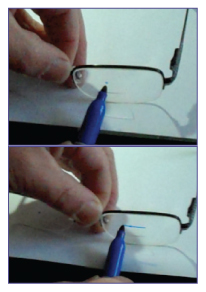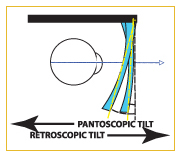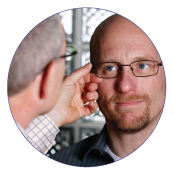|
Your monthly guide to staff training outside the box
Eyes / Lenses / Fitting Lenses / Free-Form / Frames / Sunwear / Patient Solutions / In-office / Standards
WELCOME TO CE PLUS
Do you ever think: "I remember seeing an article about that..." but can't find it easily or remember the details? The bad news is the enormous amount of information that one needs to sort through to find just the right part of that article you need. The good news is the new CE Plus.
CE Plus focuses on topics that require specific knowledge or practical how-tos for the everyday demands of your office. To save you the time, we've done the research to deliver a set of specific takeaways that can be implemented right away. And when appropriate, we'll add a "resource guide" where more information can be found from accredited CE courses, L&T articles, the Opticians Handbook and other well-known sources.
This first issue's topic is Measurement-PD, Height and Tilt. It's timely since we're seeing more tablets, apps and freestanding digital devices. They make sense, especially in an environment where your customer is looking for all the ways that products can be personalized for them while it separates you from other eyewear sources.
—Mark Mattison-Shupnick
|
Measurement—PD, Height and Tilt
MEASURING TILT—AN EASY WAY
By Bob Hughbanks, ABOC, Expert Optics Inc. and Mark Mattison-Shupnick, ABOM
First, Take a Good Fitting Height

- Adjust the patient's frame to its final wearing position. Seated in front of the patient, with your eyes at the same height as their eyes, dot pupil center (fitting height).
- Then take their glasses from them and draw a straight line across the dot. Place the glasses on the tabletop and with a marking pen against the table edge; touch the dot with the pen. Slide the glasses left and right to make a really nice straight line.
- Have the patient put their glasses back on and stand up; a couple of steps from the dispensing table work well. Next, have them look out the front window at Ben & Jerry's across the street (oops, that's in the store where I work) or choose
something that is at eye level more than 20 feet away.
See Plus »
|
|


|
CLINICAL TIPS
By Palmer R. Cook, OD
 Patients who have lost an eye tend to carry their heads turned somewhat to the side of the lost eye. This should be taken into account when measuring the monocular PD by taking the PD with a PD rule, with the patient's head in its slightly turned position.
Patients who have lost an eye tend to carry their heads turned somewhat to the side of the lost eye. This should be taken into account when measuring the monocular PD by taking the PD with a PD rule, with the patient's head in its slightly turned position.
You can increase the effective width of both the corridor and the reading area of a progressive lens by using more illumination. This decreases the pupil sizes and increases the depth of focus of the eyes. It is a temporary measure that helps in adaptation, especially if the patient has not previously worn PAL lenses.
See Plus »
|
POSTURE, PREFERENCE AND MULTIFOCALS
By Barry Santini, ABOM
 Trying to ascertain in advance the postural habits for a new multifocal client is like trying to determine what you'll find at the beginning of an archeological dig. Below is a short list of things to remember:
Trying to ascertain in advance the postural habits for a new multifocal client is like trying to determine what you'll find at the beginning of an archeological dig. Below is a short list of things to remember:
- Shorter people will tilt their heads back.
- Taller people will look downward more.
- Everyone tends to tilt his or her head back while being attentive when driving.
What is the "right" position for a multifocal or a progressive? It depends on how good a sleuth you become about discovering where a patient's "sweet spot" for optimal multifocal position is. This can be a tale of trial and error. But getting experience sleuthing position problems will improve your scoring average and shorten the time needed to get your client satisfied.
See Plus »
|
Viewpoint
STILL USING A RULER?
Are you using a millimeter ruler for PDs and fitting heights? Does it define your expertise?
Competition, the Internet and new technology are placing new demands on optical staff every day. Many have suggested that they can do "just as good a set of measurements" with a millimeter ruler. Some say that these devices will replace them in the office. Others say it takes too much time.
The variety of iPad-based and freestanding floor or desktop devices is a way to free us up to do what we do best, i.e., recommend and sell the best of the newest styles of frames and the best of materials, designs and treatments in lens technologies. Factoid: The average optometric office receives 50 to 60 percent of its gross revenue from optical. The other fact about this office is that eye exam revenue and lens sales revenue are about equal. Why not consider investing in the technology of optical if a major revenue source is that side of the practice?
—Mark Mattison-Shupnick, ABOM
|
CHILDREN—TAKING THE MEASUREMENTS
By Barry Santini, ABOM
 Many younger children and infants will not sit still long enough for a pupillometer or their PD is too narrow for its range. In these cases, use an "anatomical PD" approach.
Many younger children and infants will not sit still long enough for a pupillometer or their PD is too narrow for its range. In these cases, use an "anatomical PD" approach.
Measure from the outer edge of one eye to the inner edge of the companion eye. In some cases, this must be done quickly and with precision. In difficult cases, your best estimate will most likely be sufficient. Sometimes a penlight can provide a few seconds of staring by the child and allows a reflex PD.
See Plus »
|
|